
Review Article
Austin J Bus Adm Manage. 2019; 3(2): 1039.
The Spirit Level: The Inequality and the Consequences in Sociocultural Diseases. The End of Society
Pezzani F*
University of Parma, Italy
*Corresponding author: Fabrizio Pezzani, SDA Distinguished professor, Degree in Economics, University of Parma, Italy
Received: November 21, 2019; Accepted: December 19, 2019; Published: December 26, 2019
Abstract
We are facing an anthropological crisis, not economic. The debate on economics and its methods of study cannot be divorced from a correct reading of history that in the long term tends to repeat itself, as G.B. Vico had envisioned; the nature of man never changes, constantly oscillating between Cain and Abel, and it would seem that only pain leads man to wisdom. The single technicalrational thought makes us see the future as the only guarantee of success and we therefore cannot understand the correlations between causes and effects in our history. We act as if the past had been erased and as if history had never manifested similar situations to those in which we find ourselves today.
The toxic consequences of this model are socio-cultural inequality, poverty, moral degradation, a raging and permanent conflict, lack of imagination and creativity. Is all this due to an incorrect adjustment of the markets (economic crisis) or to the end of a socio-cultural model incapable of responding to the problems of man as a person not as an object (anthropological crisis)? “Once profit becomes the exclusive goal, if it is produced by improper means and without the common good as its ultimate end, it risks destroying wealth and creating poverty” (Caritas in veritate, chapter II, 21). The system taken to extremes created a concentration of financial wealth that is unparalleled in history with a sort of hegemonic senate that is superordinate to individual states. We have to return to the man and to a Welfare system in which healthcare is fundamental because in this way we can understand the solidarity and we can build a real “societas” – this world in old Latin means “alliance” – and this is a foundation of our happiness.
Inequality: The End of a Society
Social hardships grow and this can be seen by the increase in social problems and tensions highlighted by the indicators. An excellent book by Richard Wilkinson and Kate Pickett, The Spirit Level: Why Greater Equality Makes Societies Stronger highlights how increases in inequality tend to cause social problems to grow and later explode. The indicators serve to better understand empirically theories propounded in this book and in La Competizione Collaborativa. (Fabrizio Pezzani, 2011, Egea, Milan) The first point made in Wilkinson and Pickett’s book is that:
‘Not only have measures of wellbeing and happiness ceased to rise with economic growth but, as affluent societies have grown richer, there have been long-term rises in rates of anxiety, depression and numerous other social problems […] As living standards rise and countries get richer and richer, the relationship between economic growth and life expectancy weakens. […] Eventually in the long history of economic growth, countries inevitably reach a level of affluence where “diminishing returns” set in and additional income buys less and less additional health, happiness and wellbeing. […] It is the diseases of poverty, which first decline as countries start to get richer. The great infectious diseases […] – disappear, we are left with the so-called diseases of affluence ‒ the degenerative cardiovascular diseases and cancers. While the infectious diseases of poverty are particularly common in childhood and frequently kill even in the prime of life, the diseases of affluence are very largely diseases of later life’. (The Spirit Level: Why Greater Equality Makes Societies Stronger).
The imbalance between economic value and social value, normally referred to as “beyond GDP”, has been a line of research for some time now. French president, Sarkozy set up a committee comprising, among others, Stiglitz, Sen and Fitoussi to investigate this issue. Research that Robert Kennedy had been the first to call for in his 1968 election campaign, given that he realized the economic indicator was inadequate to represent the wellbeing of society and, in a more general sense, happiness. But measurement of wellbeing in a broader sense than merely considering economic aspects is no easy matter, because first the concepts of both wellbeing itself and happiness need to be defined. To do so means that the sphere of feelings, affection and love must be taken into account, aspects that are very difficult to define and measure. For instance, can a mother’s love for her child be measured?
Certainly a life that is too dependent on material aspects will sooner or later inevitably provoke a reappraisal of the need for spirituality. Today this need is growing as a response to people’s desire to overcome a sterile lifestyle based on individualism and greed, one that suffocates and annihilates the sense of social life. We will always have to start again from social capital and this can be done once the need has become widespread and interiorized. The inequality increases the sense of exclusion and isolation – remember that Cain was condemned to wander forever alone. It also diminishes the feeling of mutual trust, the foundation of a united society – social capital cannot be built up without a sense of trust. And without trust there cannot even be hope. Inequality in a cultural model as indicated above increases problems like anxiety, fear, sense of isolation, loss of self-esteem and mistrust. It leads to forms of depression, the breakup of families and abandoning school or alternatively to forms of aggression and angry protest that foment violence and criminality. It generates compensatory reactions such as drug abuse or forms of satisfaction that are expressions of a regression to uncontrolled primary needs such as bulimia and exaggerated sexuality.
Already in his works at the end of the 1930s Sorokin warned of an upward drive in stratification of American society and how this was near to the threshold beyond which an increase in social differences tend to produce an irreversible process of disintegration. In his book Social and Cultural Dynamics Sorokin focused attention on the correlation between these forms of social hardship and the level of inequality as regards income redistribution. The negative effects of inequality must also be attributed to each country’s history, its tradition for solidarity and scale of values, which become antidotes to these problems. Rural communities in Italy have always had a strong sense of solidarity and loathed behavior contrary to a widely held sense of moral values. And so even when faced with extremely harsh economic conditions the sense of solidarity and respect for moral norms condemned any behavior detrimental to this status quo. The existence of a strong, mutually agreed social capital acted as a considerable deterrent against social developments that failed to comply with this interior order.
Another element that has contributed to the breakup of American society, which is also becoming a problem in Italy, is linked to the decline of the family’s role in society. The drive towards an individualistic model in search of material happiness has led to a reduction in forms of bonds with others ‒ marriage is an immediate example ‒ but this eventually leads to an isolation that promotes confusion and a difficulty to identify with stable values. Such difficulties mainly affect the more vulnerable, weaker youngsters, who end up without any guidance and rapidly succumb to the negative lessons of street life: in 2011 one in five youngsters were victims of this.
The following charts highlight problems related to the inequality indicated above. Use of illegal drugs increases crime and infant mortality in the USA is much higher than in all European countries (Figures 1 & 2).

Figure 1: Infant mortality in rich countries is related to inequality.
Source: R. Wilkinson and K.Pickett, 2009

Figure 2: Infant Mortality Rate (2010).
The trend is somewhat similar to that seen in Italy where infant mortality is greater in areas where inequality is higher. The rate of teenage pregnancy, especially for minors, is a telling expression of a society that has failed to preserve the family bond. Abandoning school and the breakdown of family ties becomes a factor of high social instability that then becomes difficult to contain. In the same way the degree of obesity in young people is a response to frustration with a society that fails to provide guidance, with the result, as mentioned, of a return to primary needs. Other problems that affect the young are states of anxiety, insomnia, various fears and forms of anorexia or drug assumption (Figures 3-8).

Figure 3: rate of teenage pregnancies in relation to family income, from the
richest to the poorest families.
Source: R. Wilkinson and K.Pickett, 2009
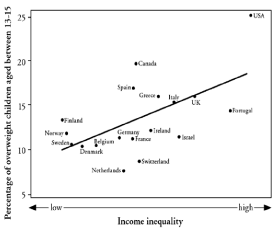
Figure 4: The percentage of overweight children is higher in countries with
greater inequality.
Source: R. Wilkinson and K.Pickett, 2009

Figure 5: Number of Deaths involving Heroin.
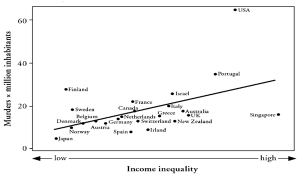
Figure 6: Murder is more frequent in countries with greater inequality.
Source: R. Wilkinson and K.Pickett, 2009
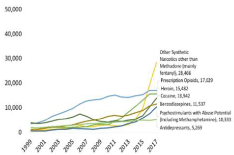
Figure 7: National Drug Overdose Deaths Number Among All Ages, 1999-
2017.
Source: Centers for Disease control and prevention, National Center for
Health Satistics. Multiple Cause of Death 1999-2017 on CDC WONDER
online Database. Released December, 2018

Figure 8: Synthetic opiate deaths continue to surge.
Source: Centers for Disease Control and Prevention
One of the natural consequence of social hardship and subsequent conflicts is violent crime: in the United States the rate is twice as high as the next ranked country (Figures 9-11).
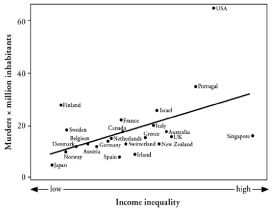
Figure 9: Murder is more frequent in countries with greater inequality.
Source: R. Wilkinson and K.Pickett, 2009
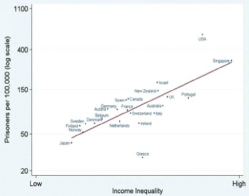
Figure 10: Rates of Imprisonment are Higher in More Unequal Countries.
Source: R. Wilkinson and K.Pickett, 2009
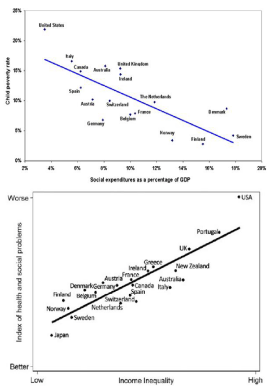
Figure 11: Social expenditures as a percentage of GDP and child poverty
in the OECD.
Crime is also in part determined by the stance taken by police officers, who on many occasions behave violently even when it is absolutely unjustified. Fear acts a strong deterrent when faced with rebellion because the oppressed are always afraid of losing what little they have. Social frustration and a sense of being abandoned induce forms of blind rage and violence that, fueled by a culture founded on personal justice, leaves the door open for acts of vandalism and mass murder, which tend to become more and more frequent, also thanks to an uncontrolled use of firearms [1-12].
Lastly, a disastrous result is low social mobility, the natural consequence in a society where classes with a higher standard of living have advantages that are effectively denied to others. This is a sure sign that the American dream has now fade (Figures 12 & 13).
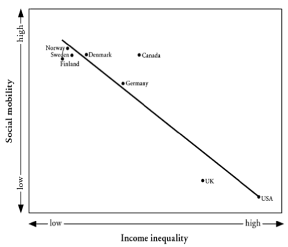
Figure 12: Social mobility is lowest in countries with the greatest inequality.
Source: R. Wilkinson and K.Pickett, 2009

Figure 13: The Great Gatsby Curve.
Source: Miles Corak, “Inequality from Generation to Generation: The United
States in Comparison.” In Robert Rycroft, ed. The Economics of Inequality,
Poverty, and Discrimination in the 21st Century (Santa Barbara, California:
ABC-CLIO, 2013).
In essence it seems evident that the crisis is a failure of a social and cultural model taken to the extreme and that reconstruction of the country must start again by reappraising the values expressed by the founding fathers. Values based on inclusion and not exclusion of the people that, over time in the mind of those responsible for government, have become nothing more than dim memories. All of this has produced a “nihilism” that is not easy to overcome, but as history teaches us, without mutual trust and hope there is no way out [12-24] (Figures 14 & 15).
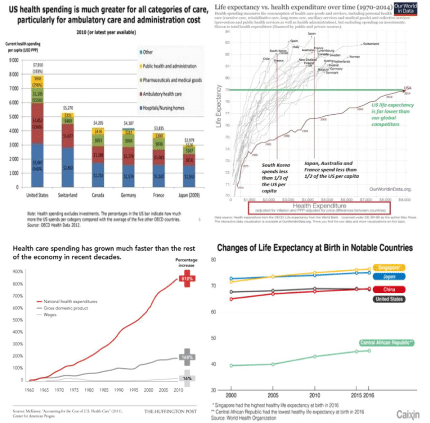
Figure 14: The dramatic Contradiction: Expenditures in healthcare are totally asymmetrical to social and right society:.

Figure 15: Health expenditure as a share of GDP, OECD countries, 2010.
Conclusions
The time has come to understand that we are facing an anthropological and not economic crisis as it is reductively defined; it is the failure of a socio-cultural model that has erased the fundamental human rights inscribed in 1948. The response to the crisis as anthropological is in understanding the cultural and historical path that has brought us to chaos, overthrowing the dominant paradigm, to place man and society at the center of our interests as an end and to bring economics back to its natural role as a means. The technical culture, master of the world has unnaturally transformed economics as a social science into an exact science; in the exact sciences, we study the relationships between measurable things to define universal laws, but in the social sciences, such as economics, we study relationships between men where human subjectivity does not allow defining universal laws.
It is time for people to realize what happens to a society when it fails to invest in social relations and the need imposed by history to again make social capital the focus of our interests. We must understand that social capital cannot be replaced by economic capital. A good society is always the precondition for growth of economic values and empirical evidence would seem to confirm this thesis.
But the question is whether we will manage in time to dominate this current, limitless greed and aggressiveness in favor of a greater focus on a sense of fraternity and solidarity expressed by love for others. Homo sapiens really does seem to be rather stubborn as regards understanding its own errors. A species that seems to be very attentive as regards learning the causes and effects of physical ills but that has not yet managed to correlate causes and effects in its history. Conceptually, similar situations to those we find ourselves having to face today have occurred before. Perhaps this explains why history is ignored, as if by doing so erects a kind of barrier to the fear of having to face suffering. Whether Homo sapiens will manage to deserve this appellation is difficult to say, time will tell if intelligence will turn out to be a benefit or a curse. Should it turn out to be a curse, this will only be because of a failure to use a truly precious gift, namely, our “humanity”, in an intelligent way.
The past few centuries have seen revolutions, wars and other tragic events that have ended, even in recent times, with solemn declarations of peace and democracy. But unfortunately in the brief course of one generation they seem to disappear. And so the history of progress of civilizations continues on a course filled with doubts. Answers to the needs of an increasingly global society represented by a culture that relies on a single philosophy – technical knowledge as an end in itself – is showing it has reached the end of the line with the collapse of society and the very essence of humanity.
References
- Cicero. On the Common wealth and on the laws, Cambridge University Press. 1999.
- Aristotele. Etica Nicomachea [Nicomachean Ethics]. Bompiani: Milan. 2000.
- Chomsky N. Failed States: the Abuse of Power and the Assault on Democracy. Il Saggiatore: Milano. 2006.
- Guardini R. The End of the Modern World. Morcelliana: Brescia. 1954.
- Keynes JM. The End of Laissez Faire. MacMillan Publishers: London. 1923.
- Keynes JM. Essays in Persuasion. MacMillan: London. 1933.
- Pezzani F. Cooperative Competition. Egea-UBE: Milan. 2011.
- Pezzani F. The Nobel Prize for mythical finance and Colombo’s egg. Bus Econ J. 2016.
- Pezzani F. Independence day and forgotten equality. Bus Econ J. 2016.
- Pezzani F. The gold exchange standard and the magic trap of paper money. J Accoun Finan Audit. 2017; 5: 23-32.
- Pezzani F. Once upon a time in America and the end of the American dream. Journal of Socialomics. 2017.
- Pezzani F. Society the foundation of the economy. We need a socio cultural revolution. Scholar’s Press: Germany. 2017.
- Posner R. The crisis of capitalist democracy. Egea-UBE: Milan. 2010.
- Prigogine I. La fin des certitudes. Temps, chaos et les lois de la nature. Odile Jacob: Paris. 1996.
- Putnam R. Social capital and individualism. Il Mulino: Bologna. 2004.
- Russell B. The scientific outlook. Laterza: Rome-Bari. 2009.
- Sigmund F. The Discomforts of Civilization. Bollati Boringhieri: Turin. 1971.
- Sigmund F. The Future of Illusion. Boringhieri: Turin. 1971.
- Sorokin P. Social and cultural dynamics. Utet: Turin. 1941.
- Sorokin P. The Crisis of our age. EP Button & Co: New York. 1941.
- Toynbee AJ. Civilization on trial. Bompiani: Milan. 1949.
- Toynbee AJ. Mankind and mother earth. Garzanti: Milan. 1977.
- Vico G. La scienza nuova [The New Science]. Napoli. 1725.
- Zygmunt B. Liquid Life. Laterza: Bari. 2005.